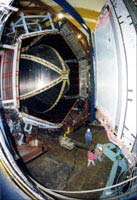Physicists in Japan and US find new form of matter

Analysis of data from Jefferson Lab’s CEBAF Large Acceptance Spectrometer supports the pentaquark discovery recently announced by the SPring-8 physics lab in Japan. <br>
Physics Lab in Japan reports evidence for the Pentaquark; Jefferson Lab data supports discovery
A Five-quark state has been discovered, first reported by a group of physicists working at the SPring-8 physics lab in Japan. All confirmed particles known previously have been either combinations of three quarks (baryons, such as protons or neutrons) or two quarks (mesons such as pions or kaons). Although not forbidden by the standard model of particle physics, other configurations of quarks had not been found till now. The “pentaquark” particle, with a mass just above 1.5 GeV, was discovered in the following way. At the Spring-8 facility a laser beam is scattered from a beam of 8-GeV electrons circulating in a synchrotron racetrack. These scattered photons constitute a beam of powerful gamma rays, which were scattered from a fixed target consisting of carbon-12 atoms. The reaction being sought was one in which a gamma and a neutron inside a carbon nucleus collided, leaving a neutron, a K+ meson, and a K- meson in the final state. Efficient detectors downstream of the collision area looked for the evidence of the existence of various combinations of particles, including a short-lived state in which the K+ and the neutron had coalesced. In this case the amalgamated particle, or resonance, would have consisted of the three quarks from the neutron (two “down” quarks and one “up” quark) and the two quarks from the K+ (an up quark and a strange antiquark). The evidence for this collection of five quarks would be an excess of events (a peak) on a plot of “missing” masses deduced from K- particles seen in the experiment (http://www.aip.org/mgr/png/2003/193.htm).
The Laser-Electron Photon Facility (LEPS) at the SPring-8 machine (http://www.rcnp.osaka-u.ac.jp/Divisions/np1-b/index.html ) is reporting exactly this sort of excess at a mass of 1540 MeV with an uncertainty of 10 MeV. The statistical certainty that this peak is not just a fluctuation in the natural number of background events, and that the excess number of events is indicative of a real particle, is quoted as being 4.6 standard deviations above the background. This, according to most particle physicists, is highly suggestive of discovery. (Nakano et al., Physical Review Letters, upcoming article, probably 11 July 2003; text at www.aip.org/physnews/select; contact Takashi Nakano, nakano@rcnp.osaka-u.ac.jp)
Confirmation of this discovery comes quickly. A team of physicists in the US, led by Ken Hicks of Ohio University (hicks@ohio.edu, 740-593-1981) working in the CLAS collaboration at the Dept. of Energy’s Thomas Jefferson National Accelerator Facility, has also found evidence for the pentaquark. A photon beam (each photon being created by smashing the Jefferson Lab electron beam into a target and then measuring the energy of the scattered electron in order to determine the energy of the outgoing gamma) was directed onto a nuclear target. The photon collides with a deuteron target and the neutron-kaon (nK+) final state is studied in the CLAS detector (http://www.jlab.org/Hall-B/ ). The TJNAF result was announced at the Conference on the Intersections of Nuclear and Particle Physics (http://www.cipanp2003.bnl.gov ) held on May 19-24, 2003, at New York City. Stepan Stepanyan (stepanya@jlab.org, 757-269-7196) reported at this meeting that the mass measured for the pentaquark, 1.543 GeV (with an uncertainty of 5 MeV), is very close to the LEPS value. The statistical basis of the CLAS measurement is an impressive 5.4 standard deviations. (This result is about to be submitted to Physical Review Letters.) These results, together with the previous results from SPring-8, now provide firmer evidence for the existence of the pentaquark. The HERMES experiment at the DESY lab in Germany is also pursuing the pentaquark particle.
The discovery of a 5-quark state should be of compelling interest to particle physicists, and this might be only the first of a family of such states. Not only that but a new classification of matter, like a new limb in the family tree of strongly interacting particles: first there were baryons and mesons, now there are also pentaquarks. According to Ken Hicks, a member of both SPring-8 and Jefferson Lab experiments, this pentaquark can be considered as a baryon. Unlike all other known baryons, though, the pentaquark would have a strangeness value of S=+1, meaning that the baryon contains an anti-strange quark. Past searches for this state have all been inconclusive. Hicks attributes the new discovery to better beams, more efficient detectors, and more potent computing analysis power.
Media Contact
All latest news from the category: Physics and Astronomy
This area deals with the fundamental laws and building blocks of nature and how they interact, the properties and the behavior of matter, and research into space and time and their structures.
innovations-report provides in-depth reports and articles on subjects such as astrophysics, laser technologies, nuclear, quantum, particle and solid-state physics, nanotechnologies, planetary research and findings (Mars, Venus) and developments related to the Hubble Telescope.
Newest articles

Scientists transform blood into regenerative materials
… paving the way for personalized, blood-based, 3D-printed implants. Scientists have created a new ‘biocooperative’ material based on blood, which has shown to successfully repair bones, paving the way for…

A new experimental infection model in flies
…offers a fast and cost-effective way to test drugs. Researchers at the Germans Trias i Pujol Research Institute and Hospital have reinforced their leading role in infectious disease research by…

Material developed with novel stretching properties
KIT researchers produce metamaterial with different extension and compression properties than conventional materials. With this material, the working group headed by Professor Martin Wegener at KIT’s Institute of Applied Physics…



